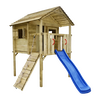Make play extra fun with remote control cars
Remote control cars have long held a cherished place in the realm of children's toys. These miniature marvels, typically operated by a handheld controller, offer kids an exhilarating experience as they navigate the terrain, zooming around corners and performing daring stunts. The allure of remote control cars lies not only in their entertaining features but also in the myriad of benefits they bring to a child's development.
The developmental benefits of remote control cars for children
One of the primary reasons children are drawn to remote control cars is the sense of control and autonomy they provide. Steering a small vehicle using a handheld device empowers kids and fosters a sense of responsibility as they learn to navigate their surroundings. This hands-on engagement contributes to the development of fine motor skills and hand-eye coordination, crucial elements in a child's overall physical development.
Furthermore, remote control cars offer an exciting introduction to the world of technology. As kids manipulate the controls to guide their miniature cars, they gain a basic understanding of cause and effect, honing their problem-solving skills. This early exposure to remote control technology can lay the foundation for an interest in more complex technological concepts later in life.
Great for outdoor play as well
The appeal of remote control cars is not limited to indoor play, as these toys provide an excellent reason for children to venture outdoors. In a time dominated by screens and digital devices, remote control cars offer a refreshing alternative to non-screen activities. The prospect of exploring the backyard or a local park while manoeuvring their remote control cars encourages kids to engage in physical activity and enjoy the benefits of fresh air and sunshine.
Moreover, remote control cars facilitate social interaction and cooperative play. Children often gather with friends to race their cars, organise obstacle courses or even create imaginative scenarios, fostering teamwork and communication skills. This shared experience enhances the social aspect of play and encourages a sense of friendship among young enthusiasts.
Parents appreciate the positive impact of remote control cars as well. Encouraging outdoor play and physical activity, these toys provide a welcome break from excessive screen time. Additionally, the versatility of remote control cars means they can be enjoyed by children of various ages, promoting inclusive playtime for siblings and friends.
How to create a fun and playful outdoor space for children
In a world dominated by screens and digital devices, fostering an engaging outdoor environment for children is crucial for their physical and mental wellbeing. Transforming your outdoor space into a haven of fun and exploration can captivate the imagination of young ones, encouraging them to embrace the joys of the great outdoors. From play swings and trampolines to sandboxes and water play areas, here's our tips to creating a vibrant outdoor area that will have kids eagerly trading their screens for sunshine.
-
Play swings:
- Classic Swings: Install a sturdy swing set with classic swings for timeless enjoyment.
- Tire swings: Add a touch of nostalgia with a tire swing, providing a unique and exciting swinging experience.
- Hammock swings: Incorporate hammock swings for a cosy and relaxing spot for kids to sway gently.
-
Trampolines: Invest in a good, safe trampoline with enclosure nets to ensure a secure bouncing experience. Choose trampolines with interactive elements like basketball hoops or target games to add an extra layer of fun. Consider in-ground trampolines for a sleek and integrated appearance in your outdoor space.
-
Sandboxes: Design sandbox areas in various shapes, such as turtles or boats, to add an imaginative touch. Provide shovels, buckets and moulds to encourage creative sandcastle building. Install a canopy or umbrella to create a shaded area, allowing kids to enjoy the sandbox even on sunny days.
-
Playhouse: Opt for playhouses that can be painted or decorated, allowing kids to personalise their space. Choose playhouses with additional features like slides, climbing walls or attached swings for a diverse play experience. Make the inside of the playhouse inviting with cushions, blankets and perhaps a small table for imaginative play.
-
Water play: Install a mini splash pad with sprinklers for refreshing water play without a full-sized pool. Create a water wall using recycled materials like PVC pipes and containers for an interactive and sensory experience. Invest in portable water tables with accessories like boats, cups and water wheels for hours of splashing fun.
-
Creative space: Incorporate chalkboard walls for artistic expression, allowing kids to draw and write outdoors. Set up an outdoor easel for painting and drawing in the fresh air. Create a nature exploration area with magnifying glasses, bug catchers, and identification guides for curious minds.
-
Additional playful elements: Install a secure zip line for an exhilarating ride across the yard. Introduce kid-friendly garden planters, allowing them to learn about plants and participate in gardening activities. Set up an outdoor music station with instruments like drums, xylophones or even pots and pans for a makeshift drum set.
By thoughtfully incorporating a variety of play elements into your outdoor space, you can create a haven where children's imaginations can flourish. From the joy of swinging in the breeze to the creativity sparked by chalkboard walls, each element contributes to a holistic outdoor experience that encourages physical activity, social interaction and a deep connection with nature. Embrace the endless possibilities of outdoor play, and watch as your kids enjoy the wonders of their own outdoor wonderland.
Tips & tricks for getting children into active play
In the age of digital dominance, getting children to step away from screens and engage in active play can be a challenging yet essential endeavour. Balancing screen time with outdoor and indoor activities not only contributes to physical health but also nurtures creativity and social skills.
-
Create a fun outdoor area: Design an outdoor space with colourful and engaging elements like play swings, trampolines, and sandboxes. Ensure outdoor play areas are easily accessible and visible, encouraging spontaneous play.
-
Lead by example: Initiate family outings that involve physical activities like hiking, biking, or sports to set a positive example. Pursue hobbies that don't involve screens, such as gardening, crafting or playing musical instruments.
-
Establish screen time limits: Implement a consistent schedule for screen time, clearly defining when and how long screens can be used. Introduce a reward system for adhering to screen time limits, motivating kids to engage in other activities.
-
Create screen-free zones: Designate specific areas in the home, such as bedrooms or dining areas, as screen-free zones to encourage alternative activities. Reserve certain hours for quality family time without screens, fostering connections.
-
Introduce interactive indoor games: Rediscover classic board games or introduce new ones that encourage strategic thinking and social interaction. Engage kids with puzzles, riddles or brainteasers to stimulate cognitive skills.
-
Encourage imaginative play: Create a dress-up corner with costumes and props to inspire imaginative role-playing. Provide building blocks or other construction toys that spark creativity and problem-solving.
-
Organise playdates and social activities: Arrange playdates with friends or participate in community events to encourage social interaction. Enrol kids in team sports or group activities to foster teamwork and friendship.
-
Plan outdoor adventures: Plan nature walks, scavenger hunts or camping trips to instil an appreciation for the outdoors. Create obstacle courses or treasure hunts in the backyard to make outdoor play adventurous.
-
Set up a creative space indoors: Dedicate a space for arts and crafts, equipped with supplies for drawing, painting, and crafting. Establish a cosy reading nook with a variety of books to encourage a love for reading.
-
Involve kids in activity planning: Allow kids to have a say in planning activities, fostering a sense of empowerment and enthusiasm. Rotate activities regularly to keep things interesting and prevent boredom.
-
Limit passive entertainment: If screen time involves educational content, choose interactive and educational apps or programs. Encourage hobbies like playing a musical instrument, learning a new skill or participating in a club.
By combining these practical tips and tricks, parents and caregivers can gradually shift the focus from screens to a diverse range of engaging activities. It's about creating an environment that stimulates curiosity, social interaction and physical activity. With a thoughtful approach, families can strike a healthy balance between screen time and active play, nurturing well-rounded and happy children.














































